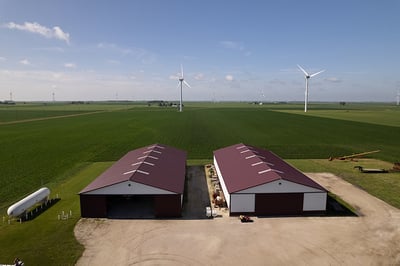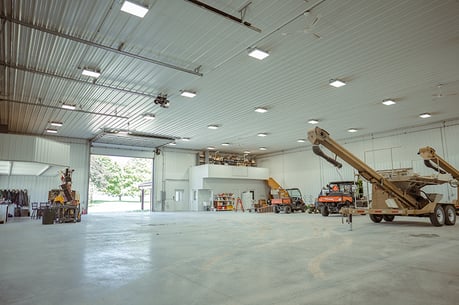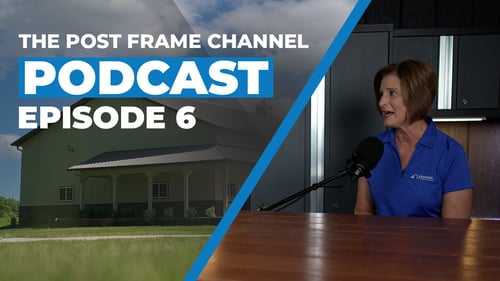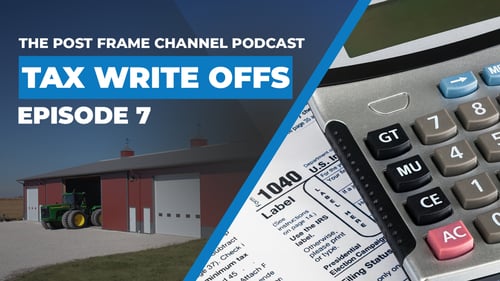Building Tips | Cost | Financing
Did You Know There Are Tax Savings for Pole Barns?
Meet FBi's Marketing Content Creator, Julie. With a design degree from Purdue, she develops our brand, captures stunning building photos, and crafts informative brochures.
If you are in the business of farming and interested in building a new post-frame barn, this article is for you. We’ll walk you through the process of how your new pole barn can be a tax write-off for your business.
You can find all the information presented in this article on the IRS website, publication 225, the Farmer's Tax Guide.
We recommend taking a look to read all the tax benefits and rules that apply to farming. For this article, we picked out the information that applies specifically to building a pole barn on your property.
We want to make sure you are prepared for the upcoming tax season by reviewing:
- What property qualifies
- How to write off your new barn
- Tax tips and best practices
1. What Property Qualifies
Let’s first clarify what the IRS considers a farming business. Both of these apply:
- You cultivate, operate, or manage a farm.
- Your goal is to generate profit or gain as either the owner or a tenant.
For a farm building to qualify as a tax write-off, your property must meet all the following requirements.
 It must be eligible property
It must be eligible property- Eligible property includes purpose-built structures to house, raise, and feed a particular type of livestock and its produce. And buildings meant to house the equipment, including any replacements needed to accommodate, raise, or feed the livestock, are also eligible.
- It must be acquired primarily for business use
- It must have been acquired by purchase
Property that doesn’t qualify as a tax write-off is the actual land that you own or land/buildings that you inherit.
Check out our Podcast Episode #6:
How to Finance Your Pole Barn Farm Shop with Compeer Financial
2. How to Write Off Your New Barn
The question is, “can a barn be a tax write-off?” The answer is yes!
You must classify the type of building you have, then decide on your desired timeline and fill out the appropriate tax form. Section 179 (pages 36 - 48 of the Farmer’s Tax Guide) provides more detailed information.
NOTE: The following guidelines only apply to agriculture buildings. These do not apply to equestrian, suburban, or other commercial buildings.
The catch is if you buy or make improvements to farm property, such as a post-frame barn, you cannot deduct its entire cost in one year.
Instead, you must spread the cost over the time you use the property and deduct part of it each year. This is called depreciation.
In a recent interview with Barry Ward, the director of OSU Income Tax Schools in the College of Food, Agricultural and Environmental Sciences, he states that single-use structures have a 10-year recovery period while general-use farm buildings have a 20-year recovery period.
We invite you to listen to our entire conversation with Barry Ward! He reviews a lot of helpful tips related to Agriculture Tax Law and how to benefit farmers!
A single-use structure is a specifically designed and engineered building to support livestock or store produce. A general-use farm building is one built to house tractors, equipment, and more.
Most of our customers fall into the “general-use farm building” category, and you can write off your building over a 20-year or 25-year period.
Most farmers will choose the 20-year option; however, if you have a slower year, you can opt into the 25-year plan. But once you select a plan, you must stick with it throughout the depreciation process.
To learn more about the write-off recovery period for other agricultural expenses, such as a grain bin, machinery, tile drainage, trucks, horses, fences, and more, check out this Depreciation: Class Life document from RuralTax.org
One of the biggest takeaways from our conversation with Mr. Ward is that he brought to our attention that the Tax Cuts and Jobs Act made it possible for farmers to completely write off their general-farm buildings 100% once the construction was completed.
This is known as First-Year Bonus Depreciation.
The 100% bonus depreciation can be applied to any completed post-frame building and placed in service before January 1, 2023. After that, first-year bonus depreciation goes down as follows:
- 80% for property completed during the 2023 calendar year
- 60% for property completed during the 2024 calendar year
- 40% for property completed during the 2025 calendar year
- 20% for property completed during the 2026 calendar year
So to all our Ag customers that completed their building this year, congratulations! You can opt into the First-Year Bonus Depreciation plan, and completely write off your building on your taxes 100%. To all the customers with a building under contract and it will be completed during 2023, you can write off 80% of it on your taxes in the first year and then the remaining 20% over a 20-year period.

Fun fact! The First-Year Bonus Depreciation option also applies to improvements made to any original general-use farm building. Examples include a new roof, finished steel liner, security system, HVAC, and fire protection system. This option does not extend to any add-ons you build onto the building.
The First-Year Bonus Depreciation option is just that, an option. You don’t have to go this route if you choose not to. We’re just here to let you know it’s available.
Now that you know whether your building qualifies as a structure or building and what your write-off timeline will look like, your next step is to complete a 4562 Form.
You must complete and attach it to your tax return every year throughout the depreciation process.
If you need help filling out the form, there are several resources online that will take you line-by-line. Here are a few to help get you started:
- IRS Website - Instructions for Form 4562 (2021)
- YouTube - IRS Form 4562 Line-by-Line Instructions 2022
The 4562 Form is to be used for any depreciating asset, not just a building. You can use it for any purchases or improvements made to your farm property with a useful life of more than a year. Examples are machinery, equipment, or livestock.
3. Tips to Help Set You Up for Success
Filing your taxes can feel like a daunting and overwhelming task for most, especially small business owners, such as Farmers in your case. Here are a few tips to help you feel prepared:
-
Be organized and keep records of all your expenses
Your recordkeeping system should include a summary of your business transactions, which shows your gross income and any expenses, deductions, and credits you are reporting. In addition, you must keep supporting documents, such as invoices and receipts, for purchases, sales, payroll, and other business transactions. -
Read through the Farmer’s Tax Guide
This resource is your best friend. It will answer all your questions and provide detailed examples to help you better understand the rules and how they apply to you. -
File early
The sooner your taxes are filed, the more assured you can be that they were correctly submitted and ahead of the deadline. This way, you won’t get any surprises from the IRS later. Filing earlier may also lead to a quicker turn-around time on your refund.
Will You Be Using the First-Year Bonus Depreciation?
Your structure/building isn’t the only thing you can designate as a tax write-off.
Take the time to learn how to make the system work for you and your family farm. Then, when you’re ready to invest in a new barn, FBi Buildings be here to help!





